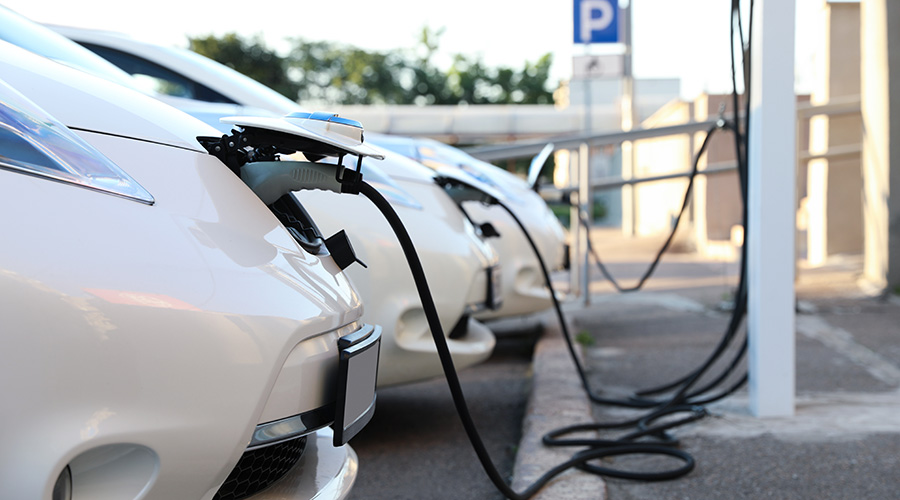4 Considerations for Installing Electric Vehicles Chargers at Commercial Sites
Vehicle chargers emerge as essential investment for future workplace.
By Ryan Gram, P.E., and Jess Cain, P.E., Contributing Writers
Did you know it is projected that the electric vehicle (EV) adoption rate will be over 50 percent by 2030 in the U.S.? Just four years ago, it was projected that the EV adoption rate would be 21 percent by 2030. In other words, we are seeing significant traction in consumer demand to own EVs. Automakers across the globe are investing heavily in the development of EVs.
Couple that with the U.S. government pouring billions of dollars into charging infrastructure and tax rebates, and it becomes clear that all signs are pointing toward an EV revolution that facility managers need to prepare for at their commercial and institutional facilities.
This article will show you what you need to consider to properly equip your commercial site with EV chargers.
Funding
The government is investing heavily in developing the necessary infrastructure to support the mass adoption of EVs. Under the Inflation Reduction Act (IRA), which was signed in August of 2022, commercial property owners may be eligible to receive a tax credit equal to 30 percent of the cost of improvements on a site (up to $30,000) depending on the location of the site. The credit will help cover both the cost of the EV charging equipment and the installation. The IRA also provides a $7,500 tax credit for the purchase of new EVs and a $4,500 tax credit for the purchase of used EVs.
The National Electric Vehicle Infrastructure (NEVI) Formula Program was signed into law as part of the Infrastructure Investments and Jobs Act (IIJA). This program is providing states with $7 billion to develop 500,000 charging stations throughout the country. The details of how these funds will be dispersed will vary from state to state. Depending on the location of your commercial site, you may be eligible to receive funding from the state for the installation of EV chargers through the NEVI Formula Program. States are issuing requests for proposals now to implement their NEVI Plan, making it vital to act now so you can receive funding. The best way to determine if your site is eligible is to contact an EV consultant.
Charger types
The grid, the grid, the grid. Managers will hear a lot about grid capacity as it relates to EV chargers. The reason it’s talked about at length is the grid is the biggest bottleneck for adopting EVs in mass. The grid can only put out as much energy as is generated and stored.
To mitigate grid overuse, it’s imperative to understand the charging behavior of your users. Below is a brief overview of the types of chargers:
- Level 1 — Generally used for in-home charging. It will take more than 30 hours to fully recharge a battery. The least expensive to install.
- Level 2 — Typically used for commercial charging but can be used for residential. 8–12 hours to fully recharge a battery.
- Direct-Current Fast Charger (DCFC) (sometimes referred to as Level 3) — Typically used for commercial charging. 30 minutes to recharge a battery to 80 percent.
Let’s consider a few different commercial sites. At an office building, it can be anticipated that the typical user is going to spend eight hours per day at the site, so Level 2 chargers would be recommended. At a retail center, most users will likely spend an hour or two at the site, so it might make sense to have a combination of Level 2 and DCFC chargers. Ultimately, the needs of users will dictate what type of chargers are best suited for sites. Other considerations include average trip length and the socioeconomics of users.
Once the type of chargers has been determined, the next question becomes: how will the grid support the extra electrical capacity that is needed?
Load management and software
Load management and the software selection will play a key role in managing your electrical load. Load management dictates how much electricity is used, where it goes, and when it is used. They reduce costs for the owners and protect the grid by managing the distribution of power across a given site.
This can be very challenging to navigate because most utility providers vary the rates they charge based on the gross amount of electricity that is being used. It can cost 50 percent more to charge during peak hours. Additionally, managers need to be cognizant of utility demand charges that occur when sites exceed a predetermined peak kilowatt usage. Like exceeding the data on a cell plan, the utility demand charges can be significant.
Having the proper software system will allow charging a rate that best serves users while allowing facilities to avoid the risks associated with the increased electrical costs due to utility demand charges. Additionally, load management software can help managers right-size infrastructure (more on that below). It is recommended that managers work with an EV consultant to properly implement a load management system so you can reduce risk and save money.
Right-sizing infrastructure
Right-sizing infrastructure is a key component to creating a viable EV charging site for both today and tomorrow. The last thing any site host will want to do is dig up their concrete to install more infrastructure in a year or two. Conversely, it is unwise to bear the entire cost of the installation of EV chargers upfront without proper phasing or supporting market data.
A site owner must properly plan to optimize their infrastructure so they can support current demand and the needs of their users today while looking forward to the future to support demand with minimal additional investment. It is recommended that managers future-proof sites, which involves running the necessary electrical and power conduit to parking spaces where there are plans to have EV chargers and reserving space on-site for future infrastructure. This makes a certain number of spaces EV capable, which allows for an easy installation of a new charger when demand dictates there is a need for one.
Avoid paying five times more to retrofit sites when increasing EV chargers by thinking about future expansion presently. A site that is properly right-sized will not only protect investments but will also provide the best long-term return on investment.
Several considerations need to be factored in when installing EV chargers at a commercial site. The four elements detailed in this article will be key to successfully implementing EV chargers. Many other elements should also be considered so it is recommended that you work with an EV consultant. EVs are the vehicles of the future, and it is time to start planning for them now.
Ryan Gram, P.E., is a civil engineer and project manager and Jess Cain, P.E., is a civil and environmental engineer for Kimley-Horn. Gram specializes in implementing EV infrastructure and has been working on EV projects since 2014. Cain has more than 20 years of experience in the EV industry, renewable energy and telecommunications and has led a large array of EV projects including charging stations.
Related Topics:












